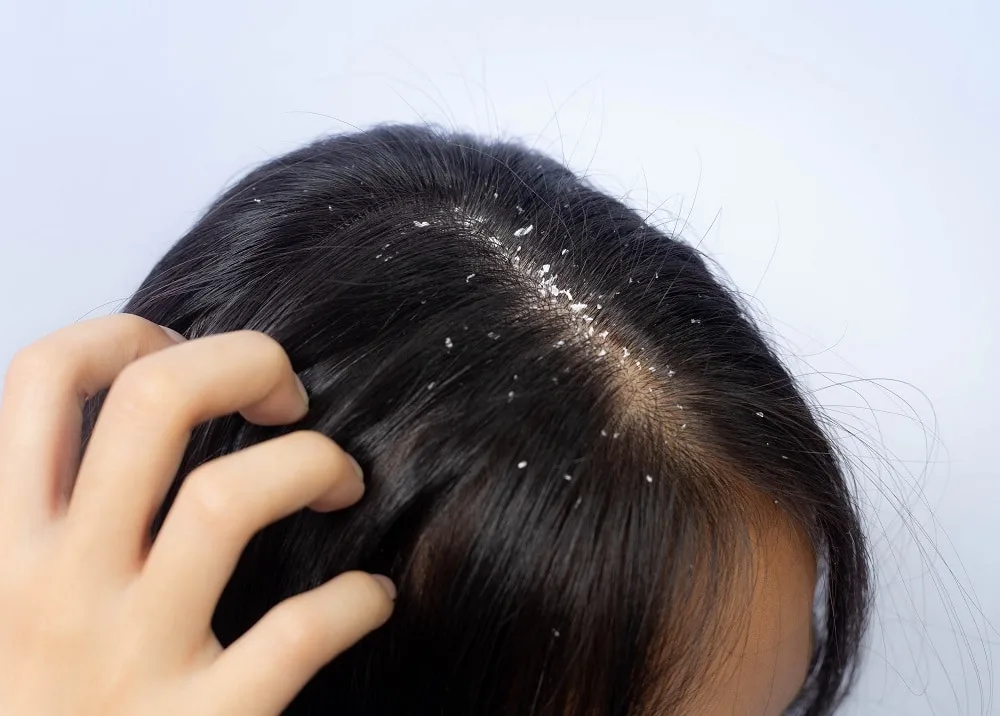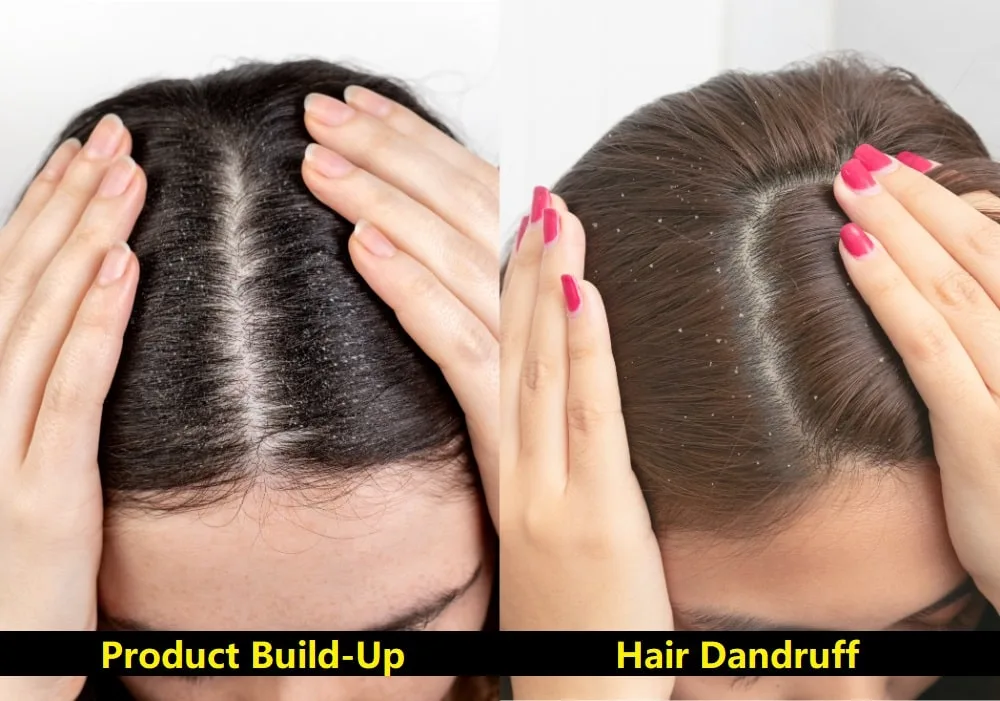If you’re dealing with white or off-white flakes on your clothes and in your hair, you know that you have either dandruff or product build-up–the issue is determining which one!
To get rid of the unsightly white flakes, you must first know which problem you’re dealing with before choosing a solution.
There are several key signs to decide whether or not you have product build-up in hair vs dandruff. Keep reading to determine whether you have product build-up or dandruff and how to help your hair recover.
What Is Hair Product Build-Up?

Many hair products, including shampoo, conditioner, hair spray, and more, are not entirely water-soluble. These products can have components that don’t dissolve in water and leave behind residue.
Most of the time, you won’t have an issue with these non-soluble components. Sometimes, however, if you aren’t rinsing your hair thoroughly or are using too much product, the residue can build up and shed in small, sticky flakes that look like dandruff.
Products likely to cause build-up include:
- Silicone-containing shampoos
- Silicone-containing conditioners
- Hair sprays
- Dry shampoos
- Hair gels
- Mousse
How to Tell If You Have Product Buildup in Hair?
Product build-up will be white and not off-white or yellow-like skin flakes. You can also consider whether you’re using products that may result in residue.
If you frequently use hair sprays, gels, or other hair products, any flakes or shedding are likely the results of buildup rather than dandruff.
Additionally, scalp build-up usually results in greasy or unclean hair, unlike dandruff, which generally only has a greasy scalp.
The easiest way to tell if you have product build-up is to look for a sticky feeling. Products left behind in your hair will stick to your hands instead of flaking off.
How to Fix Hair Product Build-Up?
There are a few ways to fix the problem of product build-up. Here are a few things to try:
- Use a clarifying shampoo: Clarifying shampoos can fix build-up issues, whether they are built-up grease, oil, sebum, or hair products.
- Micellar Water: Micellar water can be a beneficial one-time treatment to remove product build-up. Micellar water can do a good job dissolving oils and residue left behind from many hair care products.
- Baking Soda: Making a 1:1 mixture of baking soda and shampoo to use as a hair cleanser is another excellent way to eliminate product build-up.
What is Dandruff?

Dandruff is a skin condition that results in skin flakes coming off the scalp. Dandruff usually causes itchiness and can appear on other parts of your face with hair, including your beard, eyebrows, and mustache.
There are multiple causes of dandruff, including yeast overgrowth, dry skin, oily skin, or skin conditions like eczema or psoriasis.
One of the major causes of Dandruff is a yeast organism called Malassezia globosa. This microscopic yeast organism feeds on the oils on the scalp and breaks them down, causing flakiness on the scalp.
How to Tell If You Have Dandruff in Your Hair?
You likely have dandruff in your hair if you see dry, off-white flakes accompanied by itchiness or discomfort.
If you run your hands through your hair or scratch your scalp, you may notice off white or yellow flakes falling onto your neck and clothing.
Flakes falling signifies that you may have dandruff, not product build-up, which would likely stick to your hands and hair.
To determine if the flakes you see result from dandruff, you can also consider the amount of product you use. If you don’t use hair sprays or gel or already use a silicone-free shampoo, the build-up in your hair is likely dandruff.
How to Get Rid of Dandruff?
The best way to fix dandruff is to solve the root cause of the issue. Figuring out what is causing your dandruff can be difficult, but you can start with simple treatments that you can use on multiple types of dandruff. For example, these scalp treatments or other products may help.
- Dandruff Shampoo: Dandruff shampoo helps solve the most common causes of dandruff, including skin buildup and oily scalps.
- Tea Tree Oil: Tea tree oil is scientifically proven to help treat dandruff. It has anti-inflammatory and antimicrobial aspects that may help reduce your dandruff if it results from yeast overgrowth, which is one of the most common causes of dandruff.
- Coconut Oil: Coconut oil is another natural remedy to help create a healthier scalp. It is also a moisturizer, so this is the perfect first thing to try for dryness.
If you have attempted a few different things to fix your dandruff and the problem persists, it may be time to visit your general practitioner or a dermatologist.
What Does Hair Product Build-Up and Dandruff Look Like?

Hair product build-up is usually sticky, small flakes that may appear less consistently than dandruff. It is usually purely white, unlike dandruff, which may be off-white or yellow.
The key difference to look for is the size and color of the flakes. Dandruff is usually not completely white and has larger flakes, while product build-up has smaller flakes that are usually totally white.
Difference Between Product Build-Up in Hair and Dandruff
These are the key differences to watch out for when determining if you have product build-up or dandruff.
Note that symptoms can appear differently for certain people, and some products will appear more like dandruff than product build-up.
| Product Build-Up | Dandruff |
|---|---|
| White | Yellow or off-white |
| Sticky | Dry |
| Small particles or residue | Larger flakes |
| Oily scalp | Dry or oily scalp |
| Always the result of product use | Caused by overgrowth of yeast – known as Malassezia Globosa |
| Can be fixed at home by stopping product use | May be treated at home with dandruff treatments but may require intervention from a professional |
Conclusion
When you have white flakes on your scalp, it can be frustrating to wonder if you should be treating dandruff or product build-up.
Look at the color and texture of the specs that come off your scalp. You can also look at your daily routine to determine if product build-up is likely.
If you believe the flakes on your scalp result from product build-up, you can try a clarifying shampoo, baking soda, or micellar water.
If you think you’re having issues with dandruff, you can try dandruff shampoo, tea tree oil, or coconut oil.
You must talk to a doctor about your symptoms if you’re struggling with dandruff and cannot treat it at home.
Dandruff may seem like a cosmetic issue (and it usually is), but it can sometimes result from psoriasis or eczema, both of which may require treatment.
